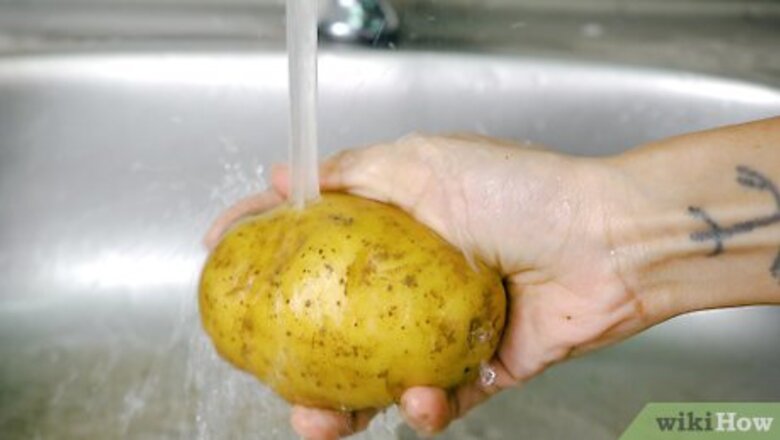
views
Washing and Prepping Your Potatoes
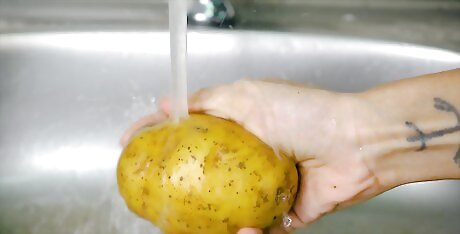
Rinse your potatoes under warm water rub them clean. Turn the water on your sink to warm and leave it on. Place each potato under the water and rub it with your clean hands for 15-20 seconds, turning it in the water as you do so. Place each potato in a clean pot or pan after you’ve rinsed it. You can use a clean produce brush to scrub the potatoes if they’ve been sitting around for a while. A quick rinse and light rub should be more than enough though. You can boil any kind of potato. The only difference between individual varieties is the cooking time.

Peel your potatoes if you want the skin off. If you want the potatoes to cook without the skin on, peel them with a potato peeler. Hold the potato in your nondominant hand and tilt it up so that you hand is underneath. Hold the peeler in your free hand and place the 2 blades at the top of the potato. Slowly pull down towards the bottom while maintaining a firm grip to remove a strip of skin. Repeat this process for the other sides of your potato. You can boil the potatoes with the skin still on. It adds another layer of flavor, although you may not want the skin in a potato salad or mashed potatoes. You can also peel the potatoes after they’ve cooked, if you prefer. When the potato is done cooking, it’s usually quite easy to pull the skin off.

Cut the potatoes into cubes or slices to speed up the cook time. If you’re in a hurry or plan on using the potatoes as an ingredient where their shape doesn’t matter, set them out on a clean cutting board. Hold the potato still using your nondominant hand and carefully cut them into smaller cubes or slices using your chef’s knife. The smaller you make your individual pieces, the faster the potatoes will cook. Cutting the potatoes into cubes will make them a lot easier to mash if you’re making mashed potatoes.
Heating Your Potatoes
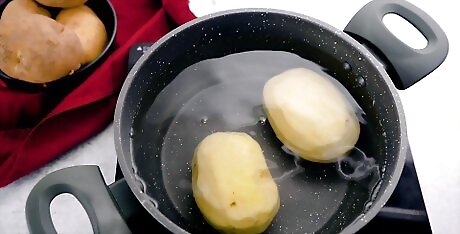
Place your potatoes in a pan or pot and fill it with cold water. If you’re cooking smaller potatoes, like new potatoes, feel free to put them in a saucepan with a taller rim. Otherwise, place your potatoes in a pot. Fill the pot or saucepan with cold water until the potatoes are completely submerged. Don’t drop the potatoes from more than 3–4 inches (7.6–10.2 cm) above the pot. You’ll end up splashing water everywhere. There needs to be 2–3 inches (5.1–7.6 cm) of space left at the top to keep the water from spilling out once it starts to boil. If your pot or pan is too small, move your potatoes to a bigger container.
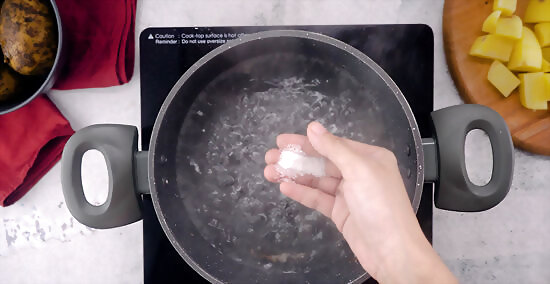
Add a pinch of salt and turn your stove on high. Before you start boiling the potatoes, add ⁄2–1 teaspoon (2.5–4.9 mL) of salt to the water to keep your potatoes cooking evenly and to add a little flavor as they soften. Turn your burner on high and cover your pan or pot with a lid. Heat the water until it reaches a rolling boil. You can boil the water without covering it, but a lid will trap the steam in and make the water boil faster. You can add garlic, bay leaves, or peppercorns to the water if you want to give the potatoes a little flavor while they cook.
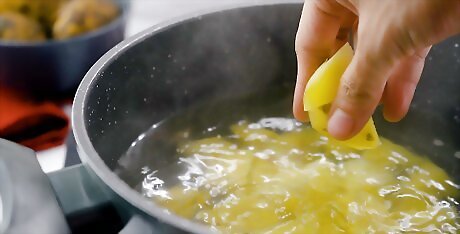
Reduce the heat to low once the water reaches a rolling boil. As soon as the water starts visibly boiling, reduce the heat to low or medium-low. Cover the pot with a lid and let the potatoes cook. The length of time required to boil your potatoes is dependent upon the species of potato that you’re cooking and whether you diced them into smaller pieces or not. Smaller potatoes and diced potatoes will cook faster than larger, uncut potatoes.
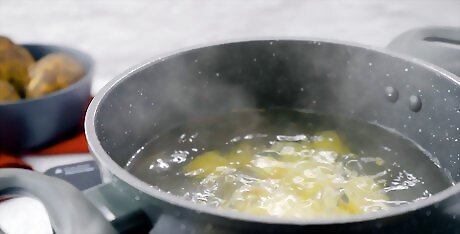
Boil red potatoes, new potatoes, or cubed potatoes for 15-20 minutes. Red potatoes and new potatoes require at least 15 minutes of boiling before they’re ready. If you cut a larger potato into smaller cubes or sections, boil them for at least 15 minutes. If the potatoes are cut into pieces smaller than 2 in (5.1 cm), cook them for 10 minutes before checking them. There’s no real harm in testing your potatoes before they’re done. You can always continue to boil them if they aren’t ready yet after you’ve taken one out for testing. Waxy potatoes, like red skin or fingerling potatoes, are particularly good for boiling. They won’t get mushy if they’re over-boiled and they tend to hold their shape really well.
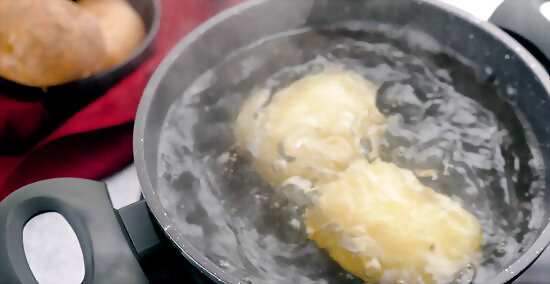
Let bigger potatoes boil for 20-25 minutes. If you’re working with larger potatoes, like russet or Ratte potatoes, let them boil for at least 20 minutes before testing them. Keep the potatoes covered while they cook. Yukon gold potatoes take a little longer than other types of potato. They’ll take roughly 25-30 minutes to finish boiling.
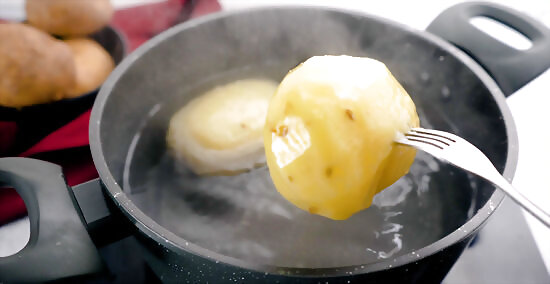
Test a potato to see if it’s done by poking it with a fork. To see if a potato is finished boiling, take one out of the pot using a pair of tongs. Set it down on a clean surface and poke the middle of the potato with a fork. If the prongs on the fork slide in and out of the potato with little resistance, they’re done. If the potatoes aren’t done, put the test potato back in the pot and cook them for an additional 2-3 minutes before checking them again. If your potatoes aren’t done but the fork does slide into them, try testing them again after 1 additional minute of cooking.
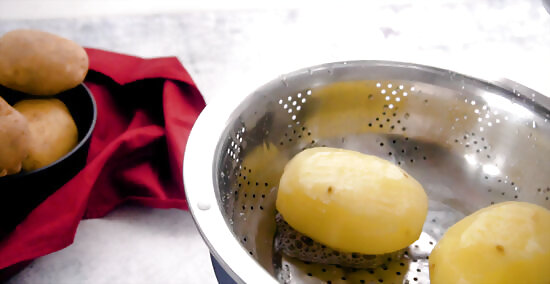
Drain the potatoes in your sink by pouring the pot into a colander. Set a colander up in your sink. Put on a pair of oven mitts and carry your pan or pot over to the sink. Carefully and slowly pour the pot or pan into the colander to drain the water. Then, either put the potatoes back in the pot or pan to season them or let them cool before continuing with your recipe. Many cooks like to put the potatoes back immediately before the potatoes have totally dried in the colander. The moisture on the surface of your potatoes can keep them moist while you keep working with them.
Boiling Potatoes in the Microwave
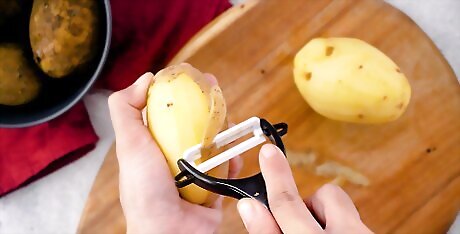
Clean your potatoes and peel them if you want the skin off. Take your potatoes to the sink and rinse them under cold water, rubbing them as they rinse to clean them. If you want the potatoes to cook with the skin on, leave it. If you want skin off, hold the potato with your nondominant hand underneath. Stick the 2 blades on your potato peeler at the top of the potato and drag it down at a 45-degree angle to peel a length of skin. Repeat this process for each section of each potato. You can use a clean produce brush to scrub your potatoes if you’d like. This will leave them really clean, although this is usually unnecessary. Boiling potatoes in the microwave is not the preferred method, since the microwave tends to heat items unevenly. The major benefit of this method is that you free up a burner if you’re making a particularly big meal.

Place your potatoes in a large, microwave-safe bowl and fill it with water. Glass is always going to be a safe bet, and unpainted ceramic will usually work as well. Check the bottom of a bowl or dish to see if it says “microwave safe.” Any microwavable container will work with your potatoes. Stick your potatoes in the bowl or container and fill it with room-temperature water until the potatoes are fully submerged. If a dish doesn’t say “microwave safe,” look for 3 squiggly lines, usually accompanied by 2-3 circles on the right. This is the symbol indicating that a dish is microwavable. You can add a pinch of salt if you’d like, but the results won’t be very noticeable when compared to stove-top boiling.
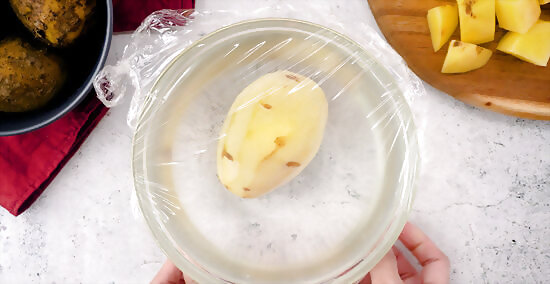
Cover the bowl with plastic wrap and poke a few holes in the cover. Pull out a length of plastic wrap and lay it over the top of your bowl. Press the wrap around the rim of the bowl to seal it and cut the excess off using the teeth on the plastic wrap’s container. Poke 4-5 holes in the plastic to create vents for the steam to escape. Place your holes evenly around the top so that the steam doesn’t build up under any section of the cover. If you don’t have the container that the plastic wrap came in, you can tear off the excess plastic or cut it with a pair of scissors.
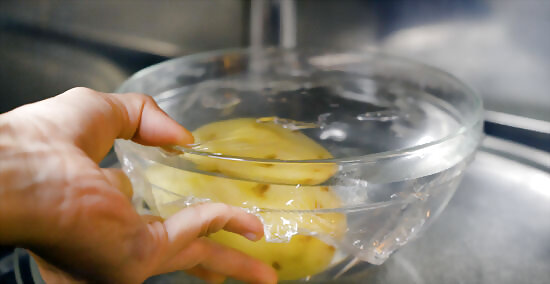
Microwave your bowl of potatoes on high for 5 minutes. Place your bowl in the middle of the microwave and close the door. Turn the microwave on high and let them cook for 5 minutes. If you have an 800-watt microwave, heat them on high for 6 minutes instead. Different microwaves have different heating patterns and temperature settings. You may need to microwave your potatoes for a little longer depending on your microwave’s make and model.
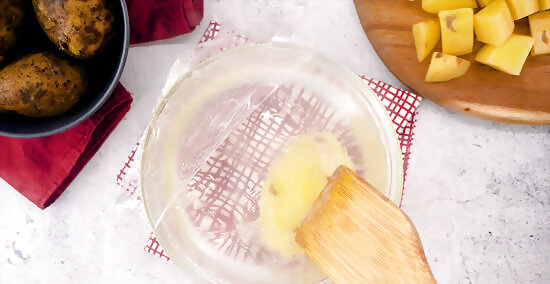
Remove the bowl and stir the potatoes before putting the plastic wrap back. The bowl or container will be hot, so put on a pair of oven mitts and carefully remove it from the microwave. Set the bowl down and carefully fold the plastic wrap back. Stir the contents with a wooden spoon for 30-45 seconds. This will circulate the water and give the potatoes a better chance of cooking evenly. The potatoes should feel a little soft as you’re stirring. This is normal, but it doesn’t mean that they’ve cooked all the way through. They still need a little more time in the microwave.

Return your potatoes to the microwave for an additional 5 minutes. Refold the plastic wrap over the bowl and put your oven mitts back on if you took them off to stir. Carefully lift the bowl back into the center of your microwave and close the door. Heat the bowl on high for an additional 5 minutes. If you’re cooking smaller potatoes and they feel relatively soft when you were stirring them, try heating them on low for 4 minutes and then test them with your fork.

Test a potato to see if it’s done by poking it with a fork. Once your potatoes have been microwaved for an additional 5 minutes, put on a pair of oven mitts and take the bowl out. Use a pair of tongs to lift a potato out of the bowl and put it on a clean surface. Poke it with the prongs on a fork to test it. If the prongs slide in and out with little resistance, they’re done. If your potatoes are still firm, heat them for an additional 1-2 minutes before testing again. The bowl will be extremely hot at this point. Do not touch it with your bare skin or you’ll risk severely damaging your skin.
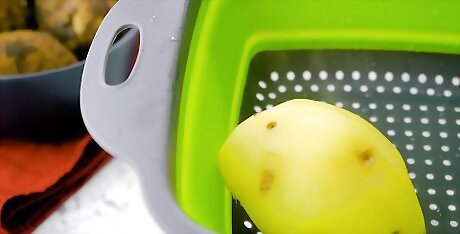
Drain your potatoes in a colander and let them cool. Place a colander in your sink and lift the bowl while wearing a pair of oven mitts. Slowly pour the bowl into the colander to drain your potatoes. Let the potatoes cool or use tongs to put them into the pot or pan that you’re going to use to continue cooking them.










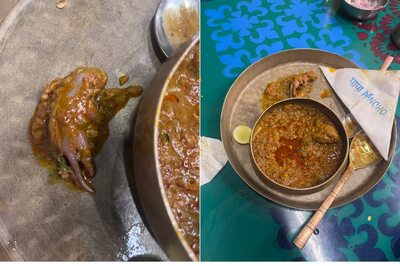
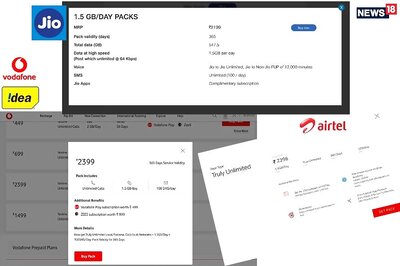








Comments
0 comment